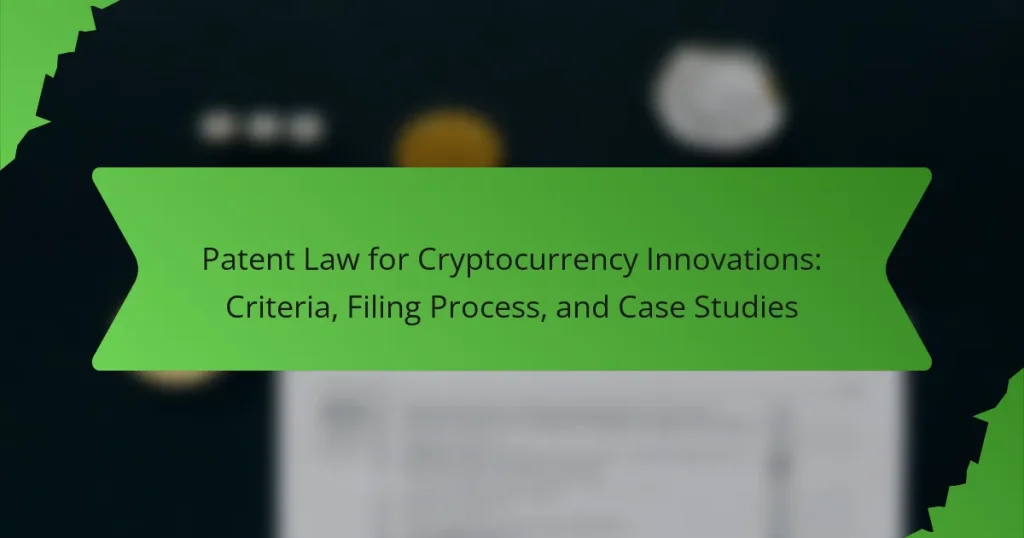Patent law for cryptocurrency innovations encompasses the legal framework that protects inventions within the cryptocurrency sector, including blockchain technologies and digital currencies. The article outlines the criteria for obtaining patents, such as novelty, non-obviousness, and usefulness, as well as the systematic process involved in filing a patent application with the United States Patent and Trademark Office (USPTO). Key steps include documenting the invention, conducting a prior art search, and preparing a comprehensive patent application. Additionally, the article highlights notable case studies, such as IBM’s patent for secure data sharing and MasterCard’s method for managing cryptocurrency transactions, illustrating the competitive advantages that successful patents can confer in the dynamic cryptocurrency market.

What is Patent Law for Cryptocurrency Innovations?
Patent law for cryptocurrency innovations refers to the legal framework that governs the protection of inventions in the cryptocurrency space. This includes the processes and criteria for obtaining patents on technologies related to blockchain, digital currencies, and associated software. Patent law enables inventors to secure exclusive rights to their innovations, preventing others from making, using, or selling the patented technology without permission. In the United States, the United States Patent and Trademark Office (USPTO) reviews applications based on criteria such as novelty, non-obviousness, and usefulness. Successful patents can provide significant competitive advantages in the rapidly evolving cryptocurrency market.
How does patent law apply to cryptocurrency innovations?
Patent law applies to cryptocurrency innovations by allowing inventors to protect their unique technological advancements. This includes algorithms, processes, and systems that improve cryptocurrency functionality. To qualify for a patent, the innovation must be novel, non-obvious, and useful. Patent eligibility often hinges on whether the innovation provides a specific technical solution. For instance, blockchain technology can be patented if it meets these criteria. The U.S. Patent and Trademark Office has issued patents related to cryptocurrency, demonstrating its applicability. However, abstract ideas, such as basic concepts behind cryptocurrencies, are not patentable. This distinction ensures that only specific implementations receive protection, fostering innovation while preventing monopolization.
What are the key components of patent law relevant to cryptocurrencies?
The key components of patent law relevant to cryptocurrencies include patentability criteria, filing procedures, and enforcement mechanisms. Patentability criteria determine whether a cryptocurrency invention is novel, non-obvious, and useful. Filing procedures involve submitting a patent application to the relevant patent office, detailing the invention’s specifications. Enforcement mechanisms allow patent holders to protect their rights against infringement. Additionally, the scope of patent protection can vary based on jurisdiction, impacting how cryptocurrencies are patented. Understanding these components is crucial for innovators in the cryptocurrency space to navigate intellectual property rights effectively.
How do cryptocurrency innovations differ from traditional inventions in patent law?
Cryptocurrency innovations differ from traditional inventions in patent law primarily due to their decentralized nature. Traditional inventions typically involve a single inventor or organization that can be clearly identified. In contrast, cryptocurrency technologies often arise from collaborative efforts within decentralized networks. This makes it challenging to assign ownership and determine patent eligibility.
Additionally, cryptocurrency innovations frequently utilize algorithms and software, which face stricter scrutiny under patent law. Many jurisdictions, including the United States, have limitations on patenting abstract ideas and software. This contrasts with traditional inventions, which often involve tangible products or processes.
Furthermore, the rapid pace of innovation in the cryptocurrency space complicates the patent process. Traditional inventions may have longer development cycles, allowing for clearer patent filing timelines. In contrast, the fast-evolving nature of cryptocurrency can lead to overlapping patents and increased litigation risks.
These differences highlight the unique challenges faced by cryptocurrency innovators in navigating patent law.
What are the criteria for patenting cryptocurrency innovations?
The criteria for patenting cryptocurrency innovations include novelty, non-obviousness, and usefulness. Novelty means the invention must be new and not previously disclosed. Non-obviousness indicates that the invention should not be obvious to someone skilled in the field. Usefulness requires the invention to have a specific, substantial utility. Additionally, the invention must be adequately described in the patent application. This ensures that someone skilled in the art can replicate the invention. These criteria are established by patent law and are essential for obtaining a patent.
What constitutes a patentable invention in the context of cryptocurrencies?
A patentable invention in the context of cryptocurrencies must be novel, non-obvious, and useful. Novelty means the invention must be new and not previously disclosed. Non-obviousness requires that the invention cannot be easily deduced by someone skilled in the field. Usefulness indicates the invention must have a practical application.
For example, a new algorithm for enhancing transaction speed may qualify as a patentable invention. This algorithm must not be an obvious improvement over existing methods. Additionally, it should provide tangible benefits in cryptocurrency transactions.
The United States Patent and Trademark Office (USPTO) outlines these criteria in its patent examination guidelines. These guidelines help ensure that only truly innovative ideas receive patent protection.
How do novelty and non-obviousness apply to cryptocurrency patents?
Novelty and non-obviousness are critical criteria for cryptocurrency patents. Novelty requires that the invention is new and not previously disclosed. A cryptocurrency patent must demonstrate that its features or processes have not been publicly known before the filing date. Non-obviousness means that the invention cannot be an obvious improvement to someone skilled in the field. This requires a significant inventive step beyond existing knowledge. For example, if a cryptocurrency uses a unique consensus algorithm not found in prior art, it may meet both criteria. The U.S. Patent and Trademark Office emphasizes these standards in patent examinations. Thus, meeting both novelty and non-obviousness is essential for securing a valid cryptocurrency patent.
Why is understanding patent law important for cryptocurrency developers?
Understanding patent law is crucial for cryptocurrency developers to protect their innovations. Patent law provides legal rights that prevent others from using, making, or selling a developer’s invention without permission. It encourages innovation by allowing developers to secure exclusive rights for a limited time. This exclusivity can lead to financial rewards and investment opportunities. Additionally, knowledge of patent law helps developers navigate potential infringement issues. Infringement can result in costly legal battles. By understanding patent law, developers can better strategize their intellectual property management. This ensures they maximize the value of their innovations while minimizing legal risks.
What risks do developers face without proper patent protection?
Developers face significant risks without proper patent protection. They may experience loss of competitive advantage. This occurs when competitors replicate their innovations without consequence. Financial losses can arise from unauthorized use of their technology. Developers may also lose potential revenue from licensing opportunities. Legal disputes can emerge, leading to costly litigation. Without patents, developers have limited recourse against infringement. Additionally, their innovations may become publicly disclosed, losing exclusivity. This environment can deter investment and collaboration, impacting future projects.
How can patents impact the competitive landscape of cryptocurrency innovations?
Patents can significantly shape the competitive landscape of cryptocurrency innovations. They provide exclusive rights to inventors, allowing them to protect unique technologies. This exclusivity can deter competitors from entering the market with similar solutions. Consequently, companies may invest more in research and development to create novel innovations.
Additionally, patents can create barriers to entry for new startups. Established firms with extensive patent portfolios can leverage these assets in negotiations or licensing agreements. This dynamic can lead to increased consolidation within the industry.
Furthermore, patent litigation can arise, impacting companies’ strategies and resources. A study by the Blockchain Research Institute found that patent activity in blockchain technology surged, indicating a growing emphasis on intellectual property protection.
Overall, patents influence innovation trajectories and market dynamics in the cryptocurrency sector.

What is the process for filing a patent for cryptocurrency innovations?
The process for filing a patent for cryptocurrency innovations involves several key steps. First, an inventor must document their invention thoroughly. This includes detailing the technical aspects and potential applications of the cryptocurrency innovation. Next, the inventor should conduct a prior art search. This search helps to determine if similar inventions already exist.
After confirming the uniqueness of the invention, the inventor prepares a patent application. This application must include claims that define the scope of the invention. The application is then submitted to the relevant patent office, such as the United States Patent and Trademark Office (USPTO).
Once submitted, the patent office reviews the application for compliance with legal requirements. The inventor may need to respond to any office actions or rejections. If approved, the patent is granted, providing the inventor exclusive rights to the invention for a specific period.
This process is crucial for protecting intellectual property in the rapidly evolving field of cryptocurrency.
How do you prepare for a patent application in the cryptocurrency space?
To prepare for a patent application in the cryptocurrency space, conduct a thorough prior art search. This search identifies existing patents and publications related to your invention. Next, define the unique aspects of your cryptocurrency innovation. Clearly articulate how these aspects differ from existing technologies. Draft a detailed patent application that includes claims, specifications, and drawings if necessary. Ensure that the claims are precise and cover the invention comprehensively. Consult with a patent attorney who specializes in cryptocurrency to strengthen your application. This legal expertise can enhance the chances of approval. Finally, file the application with the appropriate patent office, ensuring all fees are paid and documentation is complete.
What documentation is required for filing a cryptocurrency patent?
To file a cryptocurrency patent, specific documentation is required. The main documents include a detailed patent application, which describes the invention. This application must include claims defining the scope of protection sought. Additionally, a comprehensive description of the technology and its functionality is necessary. Diagrams or flowcharts that illustrate the invention can enhance clarity. Supporting documents may also include prior art references and a declaration of inventorship. These requirements align with the guidelines set by patent offices, ensuring that the application meets legal standards for consideration.
How can developers conduct a prior art search effectively?
Developers can conduct a prior art search effectively by using comprehensive databases and search tools. They should start with the United States Patent and Trademark Office (USPTO) database. This database contains all issued patents and published applications. Developers can also utilize global databases like Espacenet and Google Patents. These platforms provide access to international patents and literature.
In addition, they should employ specific keywords and classification codes related to their invention. This approach increases the chances of uncovering relevant prior art. Developers must also review non-patent literature, including academic journals and technical publications. This literature can provide insights into existing technologies and innovations.
Finally, documenting the search process is crucial. This documentation serves as evidence of diligence in the patent application process. Following these steps enhances the effectiveness of a prior art search for developers.
What are the steps in the patent filing process for cryptocurrency innovations?
The steps in the patent filing process for cryptocurrency innovations include conducting a patent search, preparing a patent application, filing the application with the patent office, and responding to any office actions.
First, a patent search identifies existing patents to assess the novelty of the innovation. Next, the applicant prepares a detailed patent application, which includes claims, drawings, and a description of the invention.
Then, the application is filed with the relevant patent office, such as the United States Patent and Trademark Office (USPTO). After filing, the patent office may issue office actions that require responses or amendments to the application.
Finally, if the application is approved, the patent is granted, providing legal protection for the innovation. Each step is crucial for securing patent rights in the rapidly evolving field of cryptocurrency.
How do you choose the right patent office for filing?
Choose the right patent office based on jurisdiction and expertise. Consider the geographical relevance of your invention. Different countries have specific patent laws. Research the patent office’s experience with cryptocurrency innovations. Review their processing times and fees. Check their reputation for granting patents in your field. Analyze their examination procedures and appeal processes. This ensures your application is handled efficiently and effectively.
What are the timelines and costs associated with the patent filing process?
The timelines for the patent filing process typically range from 12 to 36 months. This duration includes preparation, submission, and examination phases. The costs associated with filing a patent can vary significantly. Initial filing fees can range from $400 to $2,000, depending on the jurisdiction. Additional costs may include attorney fees, which can range from $5,000 to $15,000. Maintenance fees are also required to keep a patent active, amounting to several thousand dollars over the patent’s lifetime. According to the United States Patent and Trademark Office (USPTO), the average total cost for obtaining a patent can exceed $10,000.
What challenges might arise during the patent application process?
Challenges during the patent application process include prior art issues, complexity of claims, and examination delays. Prior art can invalidate a patent if similar inventions exist. Complex claims can lead to rejections or requests for clarification. Examination delays can prolong the process, impacting the applicant’s market strategy. Additionally, applicants may face high costs associated with legal fees and filing. The U.S. Patent and Trademark Office reports that the average time for patent examination can exceed 24 months.
How can applicants address potential rejections from patent examiners?
Applicants can address potential rejections from patent examiners by thoroughly reviewing the examiner’s feedback. Understanding the specific reasons for rejection is crucial. Applicants should amend their claims to overcome cited objections. Providing additional data or evidence to support the invention’s novelty can strengthen the application. Engaging in interviews with the examiner can clarify misunderstandings. Filing a request for continued examination allows for further consideration. Utilizing the assistance of a patent attorney can enhance the quality of the response. These strategies are supported by the fact that many applications are successful through careful revision and communication with the patent office.
What strategies can be employed to navigate complex patent laws?
Engaging a patent attorney is crucial for navigating complex patent laws. Patent attorneys possess specialized knowledge in intellectual property law. They can provide tailored advice based on specific innovations. Conducting thorough prior art searches is another effective strategy. This helps identify existing patents that may affect your application. Understanding the nuances of patent eligibility is essential. Different jurisdictions may have varying criteria for what can be patented. Maintaining detailed documentation of the invention process is also important. This can support claims of originality and innovation. Staying informed about changes in patent law is necessary for compliance. Regularly reviewing legal updates helps adapt strategies accordingly.

What are some case studies of successful cryptocurrency patent applications?
Some case studies of successful cryptocurrency patent applications include IBM’s patent for blockchain-based secure data sharing. This application was filed in 2016 and focuses on improving data security through distributed ledger technology. Another example is MasterCard’s patent for a method of managing cryptocurrency transactions. This patent, granted in 2021, outlines a system for facilitating cryptocurrency payments. Additionally, the Bank of America secured a patent in 2020 for a cryptocurrency storage system that enhances security and transaction efficiency. These case studies demonstrate the innovative approaches companies are taking in the cryptocurrency space through patent applications.
What notable patents have been granted in the cryptocurrency sector?
Notable patents in the cryptocurrency sector include various innovations related to blockchain technology and digital currencies. For example, IBM has patented a method for managing blockchain data. This patent focuses on improving the efficiency of data storage and retrieval in blockchain systems. Additionally, Mastercard has received patents for its cryptocurrency transaction methods. These methods aim to enhance security and speed in digital payments. Another significant patent was granted to Bank of America for a cryptocurrency wallet. This wallet is designed to store various digital currencies securely. These patents illustrate the ongoing innovation in the cryptocurrency field. They highlight the importance of intellectual property in advancing technology.
How did these patents impact the companies involved?
Patents significantly impacted the companies involved by providing legal protection for their innovations. This protection allowed companies to secure exclusive rights to their technologies. As a result, they could prevent competitors from using similar methods or systems. This exclusivity often led to increased market share and revenue growth. Companies could also attract investment by showcasing their patented technologies. Moreover, patents enhanced their bargaining power in negotiations and partnerships. For instance, successful patent filings often led to strategic collaborations with other firms. Overall, patents played a crucial role in shaping competitive advantages for these companies in the cryptocurrency sector.
What lessons can be learned from these case studies for future applicants?
Future applicants can learn the importance of thorough research from these case studies. Understanding existing patents helps identify unique aspects of their innovations. Applicants should also emphasize clarity in their patent applications. Clear descriptions facilitate smoother examination processes. Additionally, applicants must be aware of evolving regulations in cryptocurrency. Adapting to legal changes can enhance the chances of approval. Collaboration with legal experts is crucial for navigating complex patent laws. Engaging professionals can provide insights into potential pitfalls. Lastly, applicants should document their innovation process meticulously. Detailed records can support claims of originality and utility.
How do these case studies illustrate the importance of patent law in cryptocurrency?
Case studies illustrate the importance of patent law in cryptocurrency by showcasing how legal protections can foster innovation. They demonstrate that patent law incentivizes developers to invest in new technologies. For instance, the case of Ripple Labs highlights how patent protection allowed them to secure their technology against competitors. Similarly, the case of Coinbase emphasizes how patents can provide a competitive edge in a rapidly evolving market. These examples show that patent law not only protects intellectual property but also encourages investment and growth in the cryptocurrency sector. Furthermore, they reveal the role of patents in establishing credibility and trust among users and investors. Overall, these case studies confirm that patent law is crucial for the advancement and sustainability of cryptocurrency innovations.
What trends can be observed in the types of innovations that are patented?
Recent trends in patented innovations show a significant increase in technology-focused patents. Innovations in artificial intelligence and machine learning dominate the landscape. Blockchain technology patents are also on the rise, reflecting its growing importance in various sectors. Additionally, there is a notable surge in patents related to cybersecurity solutions. The healthcare sector is witnessing an uptick in medical technology patents, particularly telemedicine solutions. Furthermore, sustainability and green technology innovations are gaining traction in patent filings. Data from the World Intellectual Property Organization indicates that technology-related patents have consistently outpaced other sectors in recent years.
How have patent disputes shaped the development of cryptocurrency technologies?
Patent disputes have significantly influenced the development of cryptocurrency technologies. These legal conflicts often determine the direction of innovation. Companies may alter their strategies based on potential litigation risks. For example, disputes can lead to increased collaboration or the creation of non-infringing alternatives. Additionally, patent claims can validate certain technologies, driving investment and research. The competitive landscape shifts as firms navigate these disputes. Historical cases, such as those involving blockchain technology, illustrate this trend. Ultimately, patent disputes shape technological advancements by enforcing intellectual property rights and fostering innovation.
What best practices should developers follow when pursuing patents for cryptocurrency innovations?
Developers should conduct thorough prior art searches before pursuing patents for cryptocurrency innovations. This helps identify existing patents and ensures the novelty of their invention. They should also clearly define the technical aspects of their innovation. Detailed descriptions and diagrams enhance understanding and support patent claims.
Engaging with a patent attorney specializing in cryptocurrency is crucial. They provide expertise in navigating complex patent laws and regulations. Developers must ensure their innovations meet patentability criteria, including novelty, non-obviousness, and utility.
Filing a provisional patent application can be beneficial. This secures an early filing date while allowing time to refine the invention. Developers should maintain meticulous records of their development process. Documentation can support claims of originality and innovation.
Regularly monitoring the patent landscape is essential. This helps developers stay informed about competitors and emerging technologies. Lastly, developers should consider international patent protection. Cryptocurrency innovations may have global implications, making international patents a strategic advantage.
Patent law for cryptocurrency innovations encompasses the legal framework that protects inventions within the cryptocurrency sector, including blockchain technologies and digital currencies. The article outlines the criteria for patentability, filing processes, and enforcement mechanisms, emphasizing the unique challenges faced by cryptocurrency developers compared to traditional inventions. It also highlights notable case studies of successful patent applications and the impact of patents on competition and innovation in the cryptocurrency landscape. Understanding these aspects is crucial for developers to navigate intellectual property rights effectively and secure their innovations.




